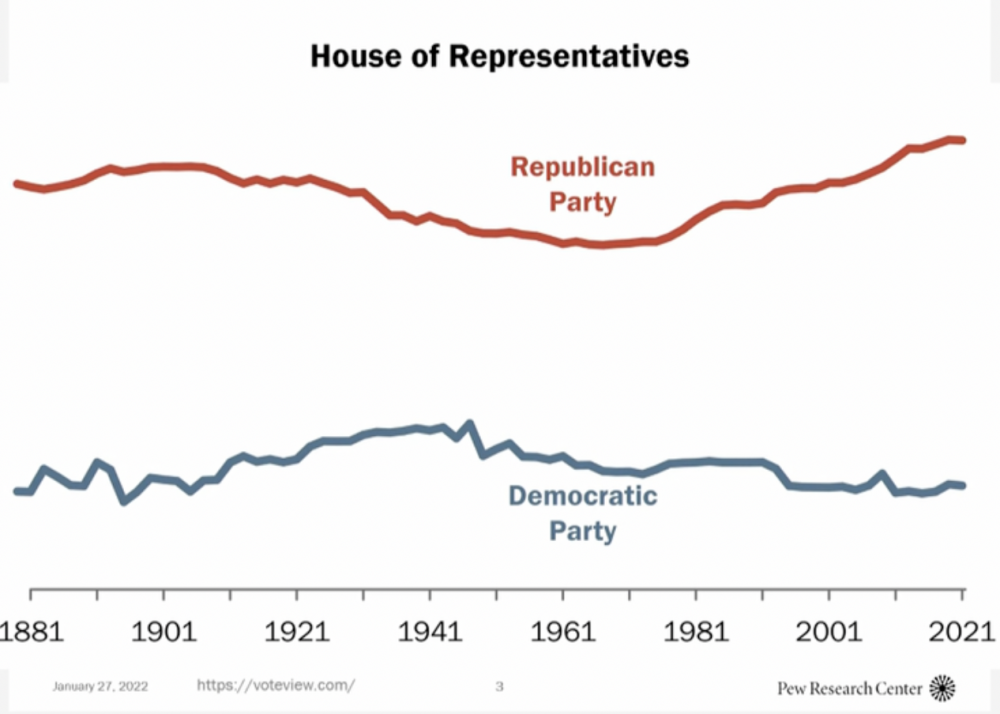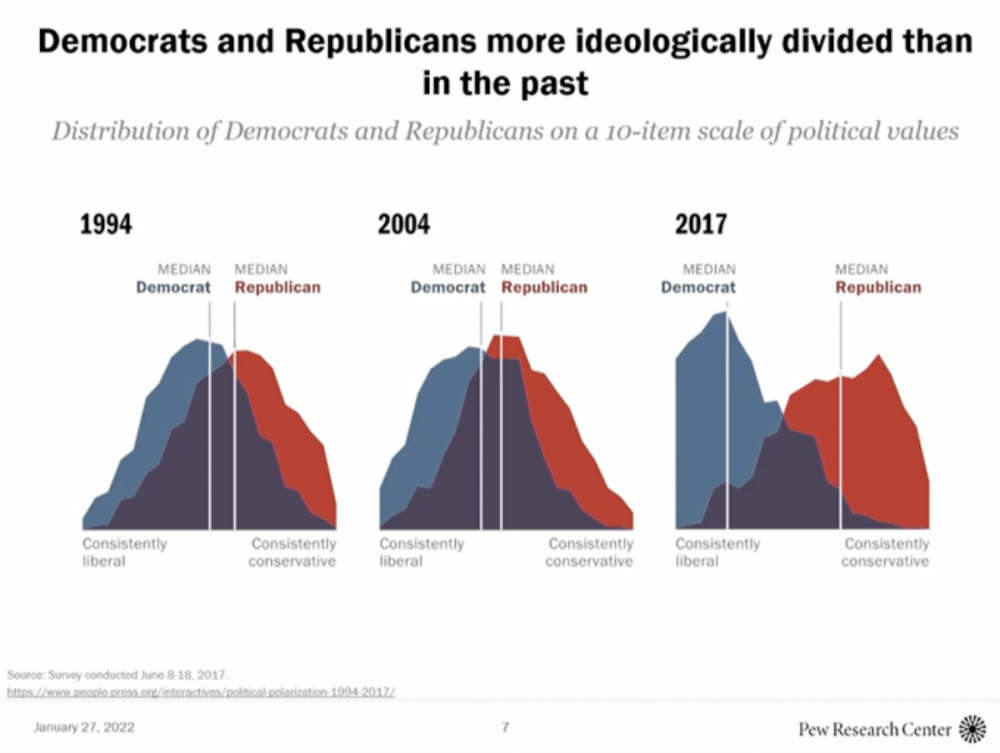Follow us on Telegram for the latest updates: https://t.me/mothershipsg
2022 is a particularly ripe year for elections.
In France, President Emmanuel Macron fended off a challenge from Marine Le Pen and won a second term. In Australia, Prime Minister Scott Morrison vies to win a full term, after his upset victory in 2019. In Pakistan, voters will cast their ballots once more after a vote of no confidence sunk Imran Khan before he could complete his first term.
Closer to home, Malaysia may be holding a general election soon.
But while all these contests will undoubtedly have far-reaching repercussions for the world in general and Singapore in particular, it's not an exaggeration to say that the most consequential of them all doesn't even involve selecting the next head of state or head of government.
The Midterms are coming
Over in the Western hemisphere, Americans will head to the polls for the midterm elections, which will be held on Nov. 8 (U.S. time).
And the results of these elections may well have consequences for years to come.
That's because these elections have a greater potential to impact the lives of American citizens more so than a presidential election.
Americans vote for the President every four years -- that tends to be the election that makes the biggest headlines around the world, and it's the one most Singaporeans will remember.
But it's the midterm elections, which take place every two years, that may have a more significant impact.
The President of the United States has lots of powers, and may enact directives by issuing executive orders, which manages the operations of the federal government.
But an executive order is not the same thing as legislation, laws which affect Americans around the country. For one thing, an executive order can be overturned by another sitting U.S. president, which means in practice they don't last long if the next president is from the opposing party.
For example, President Joe Biden couldn't simply issue an executive order to allocate US$1 trillion in infrastructure spending. Instead, he needed to work with Congress to pass a law.
And that's where the midterms come in.
There is a House in Washington D.C. they call the Rising Sun
Congress is a general term for America's legislative branch. There are two separate chambers, the House of Representatives and the Senate.
The House currently has 435 voting members, and is similar to Singapore's Parliament. Meanwhile, the Senate with its 50 members resembles the UK's House of Lords or Malaysia's Dewan Negara.
Congress is where laws are made. A bill can start in either the Senate or the House, although all bills for raising revenue must begin in the House.
Bills need to get through the House, the Senate and signed by the President before it becomes law.
The Senate holds additional powers -- they confirm the President's appointees to the Cabinet, other government officials, and judges. Biden recently nominated a Justice to the Supreme Court, Ketanji Brown Jackson, largely on the strength of votes from his own party.
So the picture becomes clearer. One party may hold the Presidency, but it would be of limited use if the other party holds either the House or the Senate.
Such a president will need to win over members of the other party before being able to pass any long-term laws, or in the Senate's case, confirm appointments. And if they can't, they might as well have the words "lame duck" tattooed on their forehead, as Barack Obama found out after the 2010 midterms, and Donald Trump after the 2018 midterms.
As we hardly need reminding, what happens in America has ripple effects on the rest of the world. The 2008 Great Financial Crisis started in America and soon plunged the world into crisis.
As then-Trade & Industry Minister Chan Chun Sing noted in 2019, Singapore is not immune to the trade war between the U.S. and China, just one of the examples how American politics affect us.
Who's up for election in 2022?
So to be clear -- Biden will still remain President after the elections in 2022.
But (almost) everything else is up for grabs.
After the contentious 2020 election, the Democratic Party held the rare advantage of holding the trifecta -- the Presidency, the House, and the Senate.
Come the midterms, every House seat will be up for election, all 435 of them.
The Democrats currently hold a slim majority, with 222 seats as opposed to the Republicans' 211, with two seats vacant.
Over in the Senate, 35 Senate seats out of 100 are up for election.
About two years ago, the Democrats won 50 seats in the Senate, which coupled with the vice president's tie-breaker vote, gave them control, albeit on a knife's edge. But two years is an eternity in politics.
Most political pundits are tipping the Republicans to record big victories, due to Biden's dipping approval ratings and inflation hitting voters hard.
But who are the people who will cast their votes and thereby determine the fate of the nation for the next two years, if not the next twenty?
As it turns out, Americans are not afraid to make their political views known -- even if they oppose each other.
Mothership attended a briefing by Bradley Jones, Senior Researcher from Pew Research Center. Jones discussed their recent findings, as outlined in their political typology report about American voters.
One of its most interesting findings? American voters may be more divided right now than at any point in the past couple of decades.
A House divided
Jones began with a slide of the "average ideological score" of the Republican and Democratic parties in the House, based on "role call voting" estimates from political scientists.
"And what I like about starting here is that it gives us a broad, historical sweep for what we’re looking at," he said. The graph starts in 1881, and goes up to 2021.
 Screenshot from Pew Research Center.
Screenshot from Pew Research Center.
Jones explained that over the past 30 to 40 years, there has been a "widening gap" between the two parties at the Congressional level, and it's similar in the Senate.
"And so over the last (few decades) – since the 1950s really, there’s been a pretty steady divergence of the two parties in the United States, and that is certainly reflected in the public opinion data that we’re going to be looking at," Jones said.
No middle
Jones said that he saw the same trend emerging in the public.
Pew Research Center came up with an ideological score based on ten items that span different substantive areas in the U.S., and in 1994, there was quite an overlap between the two parties.
However, things have changed quite a bit in just over 20 years.
"Fast forward – the last time we did this in 2017, you see that there’s basically no – there’s very few people who remain to the right or the left of the average Republican and Democrat," Jones said.
 Screen shot from Pew Research Center.
Screen shot from Pew Research Center.
Jones explained that when looking at other factors, like age, race, education, religious attendance, there's been no major change in terms of differences. What mattered was party affiliation.
"So when we look at the difference between Republicans and Democrats, in 1994 it wasn’t much different than if (we're) looking at the difference between white people and black people. Today it stands apart as the main cleavage in American politics," Jones elaborated.
He added, "partisanship (is) becoming the single dominating factor in American politics."
What will the midterms look like?
Jones touched upon the "phenomenon" where midterm elections consistently recorded a lower voter turnout than presidential elections (unlike Singapore, voting in the U.S. is not mandatory).
Stretching back to the 1950s, turnout has been more or less 10 per cent smaller in a midterm than in a presidential year.
However, Jones did point out that 2018 was kind of an outlier, where there was a "huge jump-up" as compared to 2014. 2018 was two years into Trump's presidency, and the huge gains made by Democratic politicians may have been a result of voters expressing their dissatisfaction with the president.
He noted that a consistent pattern in American politics (almost without exception) is that the incumbent party suffers losses during the midterm, and pointed out that Biden's approval ratings have dipped since his inauguration in January 2021.
According to opinion poll analytical site FiveThirtyEight, Biden's approval currently stands at 41 per cent. However, Jones also noted that approval for politicians in general, both Democrats and Republicans across the board, has trended downwards in almost every major issue, from handling the Covid-19 pandemic to immigration policy.
Jones also took a question from the audience on the possible impact on the midterm elections of the attack on the U.S. Capitol by a group of extreme Trump supporters.
He said there was a big divide between the parties on the issue, with Democrats seeing it as an unprecedented attack, while Republicans "tend to downplay" the issue.
"But it’s one of these issues where the parties are sort of digging in their heels and it seems to be maybe more a thing about motivating the base of the Democratic Party rather than turning around votes among Republicans, although we do see some Republicans who are conflicted about those attacks and assign blame to Trump and other things for the violence and destruction.
So that would be one thing to look at, how big a deal that is made of in the 2022 elections."
Top photo by Ronen Tivony/Echoes Wire/Barcroft Media and CQ-Roll Call/Inc via Getty Images
Follow and listen to our podcast here
If you like what you read, follow us on Facebook, Instagram, Twitter and Telegram to get the latest updates.
